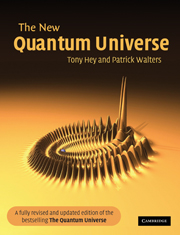Book contents
- Frontmatter
- Contents
- Preface
- Prologue
- Route map
- 1 Waves versus particles
- 2 Heisenberg and uncertainty
- 3 Schrödinger and matter waves
- 4 Atoms and nuclei
- 5 Quantum tunnelling
- 6 Pauli and the elements
- 7 Quantum co-operation and superfluids
- 8 Quantum jumps
- 9 Quantum engineering
- 10 Death of a star
- 11 Feynman rules
- 12 Weak photons and strong glue
- 13 Afterword – quantum physics and science fiction
- Epilogue
- Appendix 1 The size of things
- Appendix 2 Solving the Schrödinger equation
- Glossary
- Quotations and sources
- Suggestions for further reading
- Photo-credits
- Name index
- Subject index
4 - Atoms and nuclei
Published online by Cambridge University Press: 05 October 2013
- Frontmatter
- Contents
- Preface
- Prologue
- Route map
- 1 Waves versus particles
- 2 Heisenberg and uncertainty
- 3 Schrödinger and matter waves
- 4 Atoms and nuclei
- 5 Quantum tunnelling
- 6 Pauli and the elements
- 7 Quantum co-operation and superfluids
- 8 Quantum jumps
- 9 Quantum engineering
- 10 Death of a star
- 11 Feynman rules
- 12 Weak photons and strong glue
- 13 Afterword – quantum physics and science fiction
- Epilogue
- Appendix 1 The size of things
- Appendix 2 Solving the Schrödinger equation
- Glossary
- Quotations and sources
- Suggestions for further reading
- Photo-credits
- Name index
- Subject index
Summary
Atoms are completely impossible from the classical point of view.
Richard FeynmanRutherford's nuclear atom
Before quantum mechanics came along, classical physics was unable to account for either the size or the stability of atoms. Experiments initiated in 1911 by the famous New Zealand physicist, Ernest Rutherford, had shown that nearly all the mass and all of the positive charge of an atom are concentrated in a tiny central core that Rutherford called the ‘nucleus’. Most of the atom is empty space! A table of the relative sizes of atoms, nuclei and other quantum and classical objects is given in appendix 1. Rutherford had already won a Nobel Prize earlier, in 1908, for his work on radioactivity. Radioactivity is now known to be due to the ‘decay’ of a nucleus of certain unstable chemical elements: some radiation is given off – in the form of alpha, beta or gamma rays – and a nucleus of a different element is left behind (see Fig. 4.1). As you can imagine, it took physicists some time to disentangle what was going on, and it was Rutherford who showed that the positively charged, heavy, penetrating alpha rays were, in fact, helium atoms which had lost two electrons. Beta rays, on the other hand, were identified as electrons, and gamma rays as high energy photons. At that time, any work involving the different chemical elements was regarded as the province of chemists, and Rutherford was somewhat put out at winning the chemistry Nobel Prize.
- Type
- Chapter
- Information
- The New Quantum Universe , pp. 47 - 72Publisher: Cambridge University PressPrint publication year: 2003



